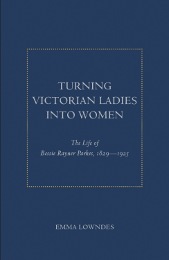Turning Victorian Ladies Into Women: The Life of Bessie Rayner Parkes, 1829 – 1925
M.Litt, University of Lisbon; under the name Ana Vicente, author of numerous studies including Women in Portugal at the Turn of the Millennium(1998), Portugal in Spanish Eyes: Diplomatic Correspondence, 1939 -1960 (1992)
 With a commendatory foreword by Professor Bonnie Anderson, CUNY Graduate Center
With a commendatory foreword by Professor Bonnie Anderson, CUNY Graduate Center
Bessie Rayner Parkes (1829-1925) was one of the most prominent and influential campaigners for women’s rights in the nineteenth century and her life and work are of remarkable interest. She is described by the American historian Bonnie S. Anderson as one of the key British feminists of her time. Surprisingly, Turning Victorian Ladies into Women is her first biography.
The author, a great-granddaughter of BRP, has made full use of previously unseen family papers and illustrations as well as of much unpublished material in the archive of Girton College, Cambridge, and in other archives on both sides of the Atlantic. The biography is about 120,000 words in length and includes 27 illustrations.
BRP’s wide circle of literary and political friends included George Eliot, Harriet Martineau, Elizabeth Barrett Browning, Robert Browning, Barbara Bodichon, Lord Shaftesbury, Herbert Spencer, Ralph Waldo Emerson, Elizabeth Gaskell, William Thackeray, Elizabeth Garret Anderson, John Ruskin, Henry W. Longfellow and Dante Gabriel Rossetti. Her most fruitful friendship was with Barbara Bodichon for, out of their efforts, grew the first organized women’s movement in Britain. Their first endeavour was to change the restrictive property laws that applied to married women. BRP was also indignant about the distinction made between ‘ladies’ and ‘women’. ‘Ladies’, that is to say middle-class women, lost social status if they earned money, the only acceptable exceptions being writing, painting or teaching, which for the most part meant ‘governessing’. In her struggle, she had to face pervasive and virulent anti-feminism. Due in part to her efforts, it became acceptable for a middle-class woman to acquire a proper education and train to do paid work. Working-class women had always belonged to the work-force, whether they wanted to or not.
A great-grandchild of the scientist Joseph Priestley, BRP was born to loving, well-off parents, in a household interested in people and ideas. Unusually for girls of her background, she was well educated at a progressive Unitarian boarding school. In her writings and in her actions she reveals a strong individual identity. Three interlocking and interdependent factors were present throughout her life story: gender, religion and class. She became acutely aware of the limitations placed on women because they were women, working for their removal; religion mattered greatly to her, and influenced her life choices, and as for class she was fully conscious of the subtle or overt differences that resulted from belonging to whatever level of society. Nevertheless, BRP crossed class lines because she also felt committed towards the improvement of the condition of working-class women, including those considered to be the dregs of society, such as prostitutes.
BRP and her friends interacted with women in other countries of Europe and in the USA, adding a very considerable international dimension to their efforts. She herself enjoyed traveling, approaching it as an educational experience, in the spirit of the time. BRP published fourteen books: poetry, essays, biography, memoirs, travel, and literature for children and young people, as well as a very effective booklet on women’s rights and dozens of articles. A lot of her literary work was well received during her lifetime and her poetry was admired by Ruskin and Longfellow.
BRP became the principal editor of the first feminist British periodical – The English Woman’s Journal - published monthly in London between 1858 and 1864. Its closure was due both to financial reasons and to the conflicts that arose among its sponsors and chief contributors, in which spoken or unspoken sexual jealousy also played a role. The offshoots that sprang from it were many and varied, such as the Society for Promoting the Employment of Women, the Victoria Printing Press (entirely staffed by women), the Law-Copying Office, and the Langham Place Group, where women gathered informally to discuss their lives or simply have a rest.
Another essential part of her life story was her slow but determined path to the Roman Catholic Church (1864). She took in all the debate around the Oxford Movement but what really impressed her was the immense amount of social work carried out by nuns. She knew the three famous English Cardinals (Newman,Wiseman and Manning)personally and discussed them in her writings.
Aged 38, BRP fell in love with a Frenchman, called Louis Belloc, himself the son of a notable woman. Their five-year long marriage, spent in France, she described as Arcadia. She never got over his sudden death. The book includes new documentation on the 1870 Franco-Prussian war which deeply hit the Belloc family on a material level. Their children, Marie Belloc Lowndes and Hilaire Belloc, went on to become renowned writers and the book looks at the development of their careers. BRP herself continued to write until late in life, and to be a keen observer of politics and society. However, after her marriage and the death of her husband, her active involvement in the organized women’s movements abated. Anguish over the stupidity of war and pride in her country coloured her feelings during the First World War. Almost at its close, her eldest grandchild, was shot down and killed in France.
Turning Victorian Ladies into Women tells the full story of a remarkable woman who with persistence and humour, mingled with breakdowns and hesitations, worked effectively for social change, as well as being committed to literature, to religion, and to her family and friends.
ACADEMICA PRESS
1727 Massachusetts Avenue, NW, Suite 507
Washington, DC 20036
